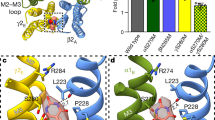Abstract.
The molecular mechanisms of general anaesthetics have remained largely obscure since their introduction into clinical practice just over 150 years ago. This review describes the actions of general anaesthetics on mammalian neurotransmitter-gated ion channels. As a result of research during the last several decades, ligand-gated ion channels have emerged as promising molecular targets for the central nervous system effects of general anaesthetics. The last 10 years have witnessed an explosion of studies of anaesthetic modulation of recombinant ligand-gated ion channels, including recent studies which utilize chimeric and mutated receptors to identify regions of ligand-gated ion channels important for the actions of general anaesthetics. Exciting future directions include structural biology and gene-targeting approaches to further the understanding of general anaesthetic molecular mechanisms.
Similar content being viewed by others
Author information
Authors and Affiliations
Additional information
Received 10 December 1998; received after revision 22 February 1999; accepted 23 February 1999
Rights and permissions
About this article
Cite this article
Krasowski, M., Harrison, N. General anaesthetic actions on ligand-gated ion channels. CMLS, Cell. Mol. Life Sci. 55, 1278–1303 (1999). https://doi.org/10.1007/s000180050371
Issue Date:
DOI: https://doi.org/10.1007/s000180050371




